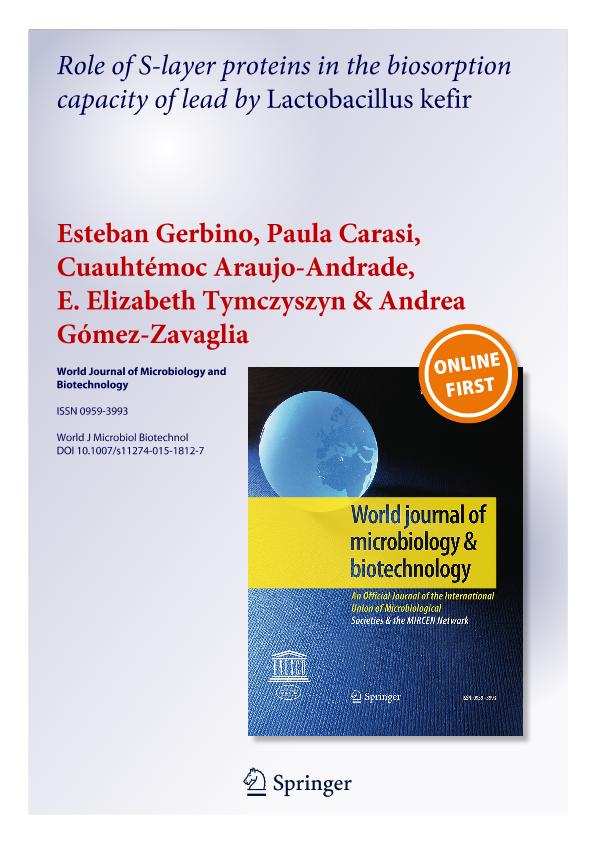Mostrar el registro sencillo del ítem
dc.contributor.author
Gerbino, Oscar Esteban

dc.contributor.author
Carasi, Paula

dc.contributor.author
Araujo Andrade, Cuauhtémoc
dc.contributor.author
Tymczyszyn, Emma Elizabeth

dc.contributor.author
Gomez Zavaglia, Andrea

dc.date.available
2016-12-26T16:33:52Z
dc.date.issued
2015-02
dc.identifier.citation
Gerbino, Oscar Esteban; Carasi, Paula; Araujo Andrade, Cuauhtémoc; Tymczyszyn, Emma Elizabeth; Gomez Zavaglia, Andrea; Role of S-layer proteins in the biosorption capacity of lead by Lactobacillus kefir; Springer; World Journal of Microbiology; 31; 4; 2-2015; 583-592
dc.identifier.issn
0959-3993
dc.identifier.uri
http://hdl.handle.net/11336/10104
dc.description.abstract
The role of S-layer proteins (SLP) on the Pb2+ sequestrant capacity by Lactobacillus kefir CIDCA 8348 and JCM 5818 was investigated. Cultures in the stationary phase were treated with proteinase K. A dot blot assay was carried out to assess the removal of SLP. Strains with and without SLP were exposed to 0–0.5 mM Pb(NO3)2. The maximum binding capacity (qmax) and the affinity coefficient (b) were calculated using the Langmuir equation. The structural effect of Pb2+ on microorganisms with and without SLP was determined using Raman spectroscopy. The bacterial interaction with Pb2+ led to a broadening in the phosphate bands (1,300–1,200 cm−1 region) and strong alterations on amide and carboxylate-related bands (νCOO− as and νCOO− s). Microorganisms without SLP removed higher percentages of Pb2+ and had higher qmax than those bearing SLP. Isolated SLP had much lower qmax and also removed lower percentages of Pb2+ than the corresponding whole microorganisms. The hydrofobicity of both strains dramatically dropped when removing SLP. When bearing SLP, strains do not expose a large amount of charged groups on their surfaces, thus making less efficient the Pb2+ removal. On the contrary, the extremely low hydrofobicity of microorganisms without SLP (and consequently, their higher capacity to remove Pb2+) can be explained on the basis of a greater exposure of charged chemical groups for the interaction with Pb2+. The viability of bacteria without SLP was not significantly lower than that of bacteria bearing SLP. However, microorganisms without SLP were more prone to the detrimental effect of Pb2+, thus suggesting that SLP acts as a protective rather than as a sequestrant layer.
dc.format
application/pdf
dc.language.iso
eng
dc.publisher
Springer

dc.rights
info:eu-repo/semantics/openAccess
dc.rights.uri
https://creativecommons.org/licenses/by-nc-sa/2.5/ar/
dc.subject
BIOSORPTION
dc.subject
LACTOBACILLUS KEFIR
dc.subject
LEAD
dc.subject
S-LAYER PROTEINS
dc.subject.classification
Otras Ingenierías y Tecnologías

dc.subject.classification
Otras Ingenierías y Tecnologías

dc.subject.classification
INGENIERÍAS Y TECNOLOGÍAS

dc.title
Role of S-layer proteins in the biosorption capacity of lead by Lactobacillus kefir
dc.type
info:eu-repo/semantics/article
dc.type
info:ar-repo/semantics/artículo
dc.type
info:eu-repo/semantics/publishedVersion
dc.date.updated
2016-12-12T14:12:19Z
dc.identifier.eissn
1573-0972
dc.journal.volume
31
dc.journal.number
4
dc.journal.pagination
583-592
dc.journal.pais
Países Bajos

dc.journal.ciudad
Dordrecht
dc.description.fil
Fil: Gerbino, Oscar Esteban. Consejo Nacional de Investigaciones Científicas y Técnicas. Centro Científico Tecnológico La Plata. Centro de Investigaciones en Criotecnología de Alimentos (i); Argentina
dc.description.fil
Fil: Carasi, Paula. Universidad Nacional de la Plata. Facultad de Ciencias Exactas. Departamento de Ciencias Biológicas. Laboratorio de Microbiología; Argentina
dc.description.fil
Fil: Araujo Andrade, Cuauhtémoc. Universidad Autonoma de Zacatecas; México
dc.description.fil
Fil: Tymczyszyn, Emma Elizabeth. Consejo Nacional de Investigaciones Científicas y Técnicas. Centro Científico Tecnológico La Plata. Centro de Investigaciones en Criotecnología de Alimentos (i); Argentina. Universidad Nacional de Quilmes. Departamento de Ciencia y Tecnologia. Area Ingenieria en Alimentos. Laboratorio de Microbiologia de Alimentos; Argentina
dc.description.fil
Fil: Gomez Zavaglia, Andrea. Consejo Nacional de Investigaciones Científicas y Técnicas. Centro Científico Tecnológico La Plata. Centro de Investigaciones en Criotecnología de Alimentos (i); Argentina
dc.journal.title
World Journal of Microbiology

dc.relation.alternativeid
info:eu-repo/semantics/altIdentifier/doi/http://dx.doi.org/10.1007/s11274-015-1812-7
dc.relation.alternativeid
info:eu-repo/semantics/altIdentifier/url/http://link.springer.com/article/10.1007%2Fs11274-015-1812-7
Archivos asociados
